Police Service Dogs: The Bark and Hold
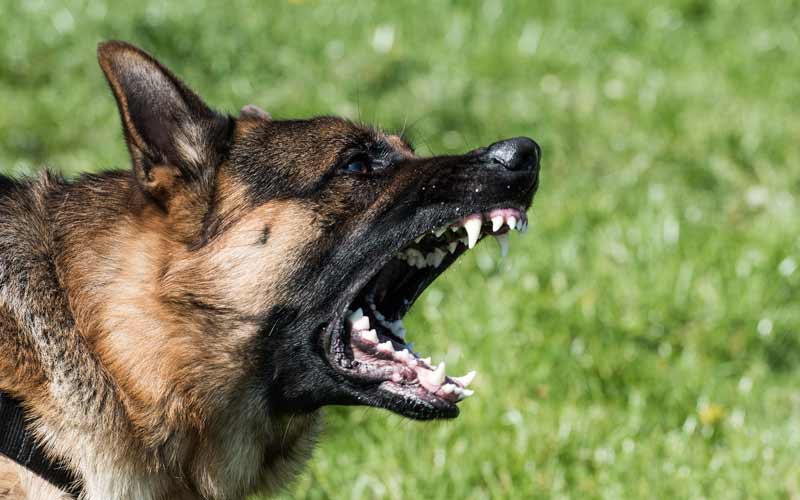
Foreword by Ed Frawley
I met Kevin Sheldahl in 1984 at a police K-9 school in Kansas. We have been good friends ever since. Kevin is a retired police K-9 handler. He became a K-9 Instructor and an International Police Dog Judge. Kevin's company K-9 Services runs 6-week police K-9 courses in which police officers learn how to become new K-9 handlers. To date, he has run 70 6-week courses and trained over 1,200 K-9 handlers. I don't know of another dog trainer that has Kevin's experience and knowledge of police service dogs training.
The bark and hold or Rever as practiced for sport is of the utmost importance in evaluating the temperament and character of the dog in the areas of courage and fighting drive. The sport judge views the dog intently during this phase of the sport trial to determine character flaws or strengths. Because of the scrutiny that is given to this exercise a tremendous amount of the training in the protection phase focuses on this point. All sport enthusiasts appreciate a spectacular dog demonstrating a clean but intense bark at the blind. The clean but pushy dog with continuous strong barking who positions himself as close as possible to the helper without interfering with him is always a crowd pleaser as well as appreciated in the judging. An educated decoy knows the strong dog the moment he arrives at the blind by his presence, attitude, and confidence in the face of the helper. The bark and hold has an analogous technique among service dogs. How does this translate to street performance or does it? Is the technique same for the Service dog as it is for the Sport Dog?
In the Sport Work the standard for performance is that the when the dog arrives at the helper he should immediately and continuously bark without bothering the helper. The closer and more intense the challenge to the helper the more the Judge will be impressed from the outset. This is most usually produced during training by teaching the dog that a bark results in action, either an immediate fight or flight by the helper. The dog learns to bait the helper into action. The moment the helper changes position from the stereotyped behavior he is free to grip the sleeve and initiate a strong fight. Admittedly this may be somewhat over simplified but in general describes the training and how the standard is obtained through it.
The Service Dog standard varies throughout the world even within the confines of the DPO type of programs which are utilized in approximately 50 Countries. When posing the question of to what level and purpose should the bark and hold be performed there will probably be just as many answers. The level of performance which pertains to this writing can be defined as; when the service dog locates a suspect who is not actively resisting or fleeing it will not engage that individual unless it's handler makes the determination that it should. In making the attempt at approaching this standard with great reliability the Service Dog must be trained in a fashion which provides consistent behavior under very complex and changing situations. To train a Service Dog as one would train a Sport Dog will produce a limited function bark and hold in many circumstances in street deployments. Methodology in the training must provide a reliable performance in the Service Dogs' environment as well as be practical from a training standpoint (ease of use as well as a means which can be applied during deployment exercises).
To understand how the Service Dog must function the problems encountered with the bark and hold must be identified and a solution forwarded to be addressed through training. The first problem is that very few people act like decoys, stand like decoys, and have the presence of a good decoy. The second is that most subjects that the Service Dog encounters are at a point of indecision. Should they fight, flee, or give up, and if they choose a behavior what will happen to them? If the Service Dog performs his skill as a Sport Dog the suspect may believe that he has no choice in the matter and that fleeing or fighting becomes his only solution to the problem at hand. Thus the Service Dog is performing to the Sport standard of be pushy, bait the helper into action with resultant fight or flight behavior. In the varied environments which the Service Dog performs his pushiness escalates to interfering with the decoy in his attempts to bait the person into action. It is not uncommon to see a Service Dog who is clean under the educated decoy or under the direct influence of it's handler yet have experiences which cause an altogether different response under uncontrolled circumstances.
The solution to these variables lies in the hands of the Service Dog handlers and instructors to find training techniques suited to their deployment needs. One of the most common methodologies is to utilize helper corrections. This is also a common beginning for sport dogs as well but there are different goals with the Service Dog than with the Sport Dogs, generally speaking. In sport the decoy corrections are utilized to provide the initiation of barking aggressively at the decoy and once this is achieved most commonly the dog is polished with a long line, back tie, or other approaches. The Service Dog helper will also utilize the helper corrections to build intensity in barking from fight drive yet at the same time will show the dog that to engage or encroach upon a suspect to closely can be dangerous and that the dog must maintain a safe distance. The dog learns that a passively behaving suspect shall not be engaged. To further this approach the dog must also tolerate movement, voice inflections ranging from fear to anger and commands from the handler and others who might be working in the environment. From the beginning the helper must be creative and change positions and attitudes routinely. When the dog is expected to engage will be upon attack by the suspect during the majority of the training (pursuits will be worked as an entirely different exercise being separated from the bark and hold technique and only added later as reliability becomes very high in the bark and hold). The dog must also learn to relinquish control of the suspect when told to by the handler. Most commonly the dog is placed in a down position but standing and returning to the handler are also practiced. The picture that is often presented by the Service Dog is that of a dog keeping his distance (6-8 feet) and with a broken but strong bark born of his fight drive. Depending on the philosophy the Service dog may either be trained to take a position or to not stop moving in the face of the suspect. The down position has been forwarded as being a very stable position for the Service Dog while performing this skill but many dogs stand or sit as well. One of the oldest philosophies is that the Service Dog should never cease moving in the face of the suspect. This provides a moving distraction to the suspect as well as teaching the dog to avoid the possibility of being struck by a weapon by the suspect. In taking this later philosophy to the extreme the dog may be taught to avoid being struck and even drop off the grip during a fight to do so and then immediately returning after avoiding the strike. We see the acceptance of these wide variety of behaviors in the rules set forth by the International Congress on Service Dogs rules for International Competition the WPO. In these rules the dog may drop off the grip during the attack on handler from the rear transport in which the decoy strikes the dog. Another approach to applying remote corrections which has become common to Service Dog training is the use of remote electrical devices. Though often deemed in a negative light the proper use of mild electrical stimulation is a harmless and effective enforcement tool which has the advantage of being completely mobile. When remote training is occurring it is often most effective for the training decoy to handle the transmitter since his timing will invariably be better than the handler's timing. The simplest and probably most effective approach to the use of the electrical stimulation equipment is to enforce a position such as down or sit upon the dog. In order to do this effectively it is important that the skill be well understood by the dog prior to initial application and that the enforcement tool is utilized initially in a controlled situation such as a back tie with a long line to guide the dog into the correct behavior and receive immediate reinforcement for the behavior. Using the approach of enforcement with the training collar usually means teaching only one skill at a time with the equipment and working with it until it is very correct. Another approach to the use of the training collar is through escape training with the collar and would require an entire article as simply an introduction to the skill. Though seen in sport dog circles as a non-acceptable device (though quite commonly used away from the scrutiny of those who might care) the modern collars actually present an alternative to physical punishment of a dog while training and enforcing skills.
Early training of the Service Dog to bark at a non-aggressive subject upon locating him must first focus on reliability. The work must come from a searching endeavor by the dog so that it learns that searching results in a barking exercise. To set this up for the dog begin by starting the skill quite early, prior to strong work in the handler protection phase and strong engagement work with the dog. In doing this decoy corrections are more effective and the pattern of barking is established prior to the possibility of simply engaging the suspect ever develops. Instead of consistently making the end result of a barking exercise always an engagement a large portion of the excursuses should end with the handler approaching the situation and taking control. This can be done by either coming to the dog and praising him for finding the suspect and barking at him, having the dog take a position, or calling the dog back to the handler. To keep the dog stimulated the suspect may run with the handler/dog team in pursuit leashed, or the dog may be sent in pursuit of the suspect after there has been a break in the barking exercise. Example; the dog locates the suspect and barks, the handler approaches and pats the dog praising him for his efforts (timing of the praise with the dog's barks and only approaching while the dog barks will encourage strong barking at this point) any attempt at encroaching upon the suspect is met with a decoy correction (effectiveness of this technique is enhanced since the dog is very new to apprehension work at this point) as well as admonishment from the handler. The handler then gives the dog a position such as heel or sit and commands the suspect to move away. Then the suspect, after at first doing exactly as he was told turns and begins to quietly move off. The handler then gives an announcement to the suspect who begins to flee. From a stable position such as a sit and surveillance position the dog is sent to apprehend the fleeing suspect. Several variations on this theme must be made to prevent the dog from anticipating the pursuit and apprehension the more creative the better. It is quite important that the handler begin to prepare the dog for events as they may occur in deployments. The handler may choose to recall his dog to a position of cover prior to the pursuit to acclimate the dog to returning to numerous areas of cover/concealment. It should be noted that at this point there have been no engagements/pursuits from the down position even though the dog should be placed in this position when the handler chooses to approach the suspect. We must prevent anticipation of engagement from this position so that we have a position where the dog understands that he is relinquishing control of the situation to the handler. On some dogs it may be important to build guarding vigilance from the down and excursuses which include engagements from the down may have to be included.
While training the above exercises the dog can be built in his apprehension work once he is showing reliability in the searching exercises. Muzzle work, suit work can both be integrated at this point into the searching exercises. During the apprehension work it is necessary that the dog be encouraged with a fighting command such as fass or pack him so that during the search work if the handler feels that it is necessary to have the dog engage the passive suspect he can do so through the same encouragement given in apprehension work. Once the dog is at full steam in the search work and reliably performs his barking upon locating the suspect this procedure can be integrated into the search work. These techniques work very well with the inexperienced dog that is correctly selection tested. Often the titled sport dog has some problems which must be addressed on an individual basis since this dog's initial training revolves around baiting the decoy.
Often while discussing the performance of Service Dogs there is a great emphasis on the dog's willingness to engage the suspect. Certainly in times of need this attribute is a necessity. I have often spoke with people who believe that the difficult to control and/or rank dog is an appropriate dog for use as a Service Dog. This may be acceptable in some circumstances but for the average American Service Dog handler control is the greatest issue since responsibility for the use of force lies on his/ her shoulders.




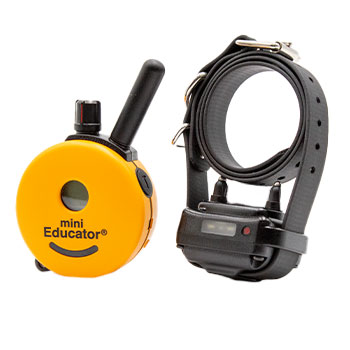
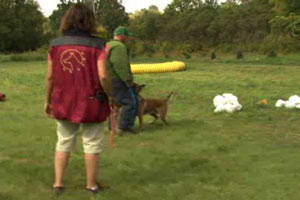
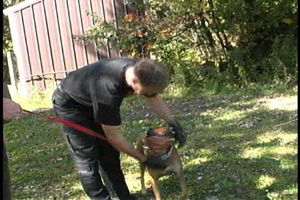

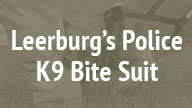
Ask Cindy.